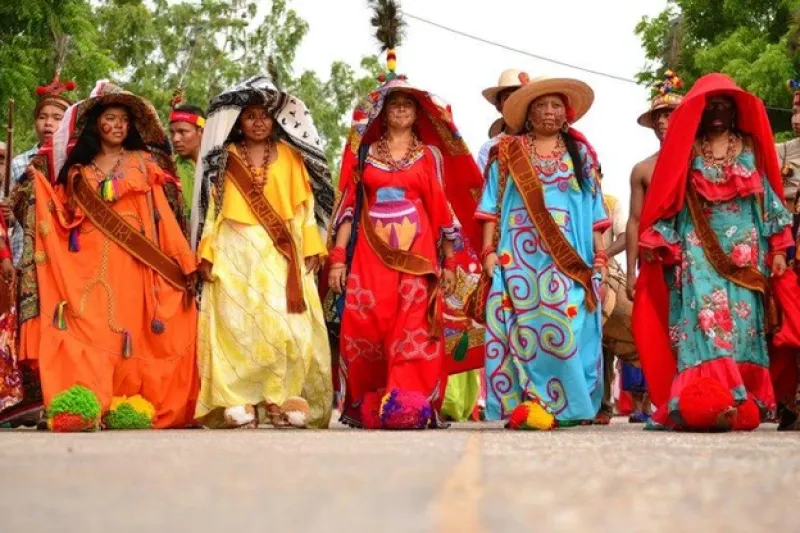Freddie Taborda | “JAMAYA PU’LAPUIN?”: A Brief Archetypal Teaching from Wayuu Aborigines to Jungian Psychology
“Jamaya Pu’lapuin?” (“How was your dream?”) are the first words with which the Wayuu greet each other daily. In contrast, when people from industrialized societies meet, they may say, “Hi”, “Hola”, “How are you?.” The greeting of ‘How are you?’ does not exist in the Wayuu language. An initial comparison of the greetings between these two groups of people may reveal the following: the Wayuu emphasize the primacy of the aa’in (soul) in life, which gets manifested in dreams, as well as the individual caring for the soul in another person’s life. Given the daily forgetfulness of the existence and subjective experience of the unconscious in the industrialized people, the word “You” in their greetings may be referring to the “Ego” and, less so to the integrated whole of the conscious and the unconscious. From a Jungian perspective, the Wayuu seem to be, initially, more interested in unconscious processes than “civilized people” are.
Therefore, Jungian analysts could learn, from the Wayuu aborigens, that the first question to be asked, when an analysand comes for the first time and to subsequent sessions to analysis, is “How was your dream?” (“Jamaya Pu’lapuin”). This is congruent with Jung’s writings and clinical practice where the centrality of dreams, as revealing the wisdom of the Self, was fundamental. There are exceptions, of course.
The Wayuu (“The People of the Sun, Sand, and Wind”) are an indigenous tribe that live in the desert of La Guajira Peninsula, which borders Colombia and Venezuela. They live in small settlements called “Rancherias,” which consists of five or six houses made of branches, corrals, and mud houses. Because their societal structure is matrilineal, each Rancheria is composed of people belonging to the same matrilineal clan. Some of these clans are, for example, the Aspushana (“Sour with Something”), the Epieyu (“Where Sleepiness is Felt”), the Jayaliyuu (“Eyes without Head”), etc. Furthermore, Wayuu children primarily bear their mother’s last name (and not the father’s), and each clan is identified with a symbolic drawing (“Kanaas”) that usually has a geometric shape that alludes to an animal, a plant, or a geographical place.
Therefore, the importance of images in Wayuu’s cosmology is comparable to the primacy of images in Analytical Psychology.
According to Paz (2017), Lapu refers to a deity that, through dreams, conveys messages to people. Dreams help the Wayuu to prognosticate many of outer events, such as death, health, adversities, etc. The Wayuu seek signals in dreams on how an adverse event can be prevented. At night, the aa’in (soul) of a Wayuu wanders, and such travel is aptly described in dreams. In recent decades, and within the field of Analytical Psychology, there is a greater tendency to see dreams as a comment, primarily, of the “analytical field” and, less so, of the intrapsychic life of the individual. The Wayuu perspective that dreams are helpful comments or warnings about outer events, such as a marriage, taking a trip, buying a house, taking a new job, moving to another city, etc, is becoming, unfortunately, less relevant to Analytical Psychologists because of the idea that “subjective interpretations” of dreams are emphasized more than “objective interpretations.” A close reading of Wayuu’s cosmology may help Analytical Psychology to have a more balanced view and hold the tension of the opposites of viewing dreams subjectively and objectively. Therefore, next time we want to relocate to another city, change jobs, have more children and, (why not?) getting together with a friend, etc., let us consult a dream about it, like the Wayuu do.
Furthermore, the aa’in or Wayuu soul is a vital energy in each Wayuu aborigen as well as in any living organism (Paz, 2017). What would be a comparable Jungian ontological category that corresponds to the aa”in in the Wayuu? I believe, “Psyche.” The aa’in is fragile in children, while it is strong and consolidated in an adult. The aa’in develops and becomes stronger over the years and, during old age, the aa’in becomes progressively weaker until it departs the human body, which corresponds to the death of the individual. When an individual falls ill, this is due to the fact that his/her aa’in has departed for quite some time and, when an individual dies, his/her soul has departed and has never come back.
When a Wayuu dies, he/she goes to Jepira -the land of the dead-, a place where the dead Wayuu go after dying. According to the Wayuu, what dies is the body, but not the aa’in (soul). The aa’in continues “living” and transforms itself into yoluja -a spirit, a non human being. The belief that the aa’in continues living is in accordance with Jung’s view, and Von Franz’s studies (1984) on dreams and death re-affirm such view:
“It is in fact true, as Jung emphasized, that the unconscious psyche pays very little attention to the abrupt end of bodily life and behaves as if the psychic life of the individual, that is, the individuation process, will simply continue. In this connection, however, there are also dreams which symbolically indicate the end of bodily life and the explicit continuation of psychic life after death. The unconscious “believes” quite obviously in a life after death.”
The yolujas (the spirits of the dead) visit the Wayuu in their dreams. Dreams are the place where the dead interact with the living, and those interactions could be positive and/or negative. For example, a yoluja of a dead relative could help, in a dream, a living relative with healing, guiding, and warning signals. Moreover, a yoluja could provide, through a dream, valuable information about medicinal plants for healing. On the other hand, a yoluja could still steal the aa’i of a child and contribute, thus, to his/her death.
Moreover, the Wayuu divides life events in terms of opposites (male/female). Rain, which is essential for survival in the desert, is the result of the union of those opposites. Similarly, in Jungian thought, opposites play a fundamental role in the human psyche, and their balance contributes to ‘water’ psychological life.
Death plays an important role in Wayuu’s culture. When a Wayuu dies, he/she needs to be buried twice in order to be transformed into rain, which will water the new life on the Earth. The spirits of the dead (“Pulasu”) are sacred, and have a great influence on life and death as well as health and sickness. The Pulasu can be contacted through dreams, and dreams are the place where the world of the living meets the world of the dead. As I have previously published (Taborda, 2010), dream characters (from a Jungian perspective) and spirits in dreams (for indigenous people worldwide), can be ontologically understood as similar, and both communicate important information on how to live life.
What would be the epistemological impact on Analytical Psychology, especially for the practice of Jungian analysis, if dreams are understood, also, as the land of the spirits of dead ancestors (“yoluja”) and spirits of living people (“aa’in”) that interact with the aa’in of the dreamer? Imagine: if dreams are the central core of Jungian Analysis, as Jung indicated, what would Jungian analysts think about defining the fundamental practice of Analytical Psychology as the process of establishing, through dream analysis, a balanced relationship between the spirits of the dead and the spirits of the living, as well as a balanced relationship among the spirits of the living in order to live a meaningful and whole live. For some analysts, this approach will be a theoretical and practical regression in their pursuit of establishing Analytical Psychology as a scientific clinical practice, which may trigger fears of “going primitive”; for others, it may be a welcoming opportunity to create a racial and cross-cultural bridge to other people, aborigens, indigenous tribes and cultures, and their descendants. Analytical Psychology is struggling with issues of racial diversity and cross-cultural competency. Learning how to practice Jungian analysis with the help of aboriginal and native cosmology from a variety of cultures may be an answer to this struggle.
(Picture Credit: Wayuu Vibes)
This post was first published as a series on thehealingpsyche.org.
Freddie Taborda, LCPC, PsyD is a Jungian Analyst with over 30 years of clinical experience. He maintains a private practice in Chicago, Illinois.
Links: Dr. Taborda’s Website | About Dr. Taborda | Dr. Taborda’s Page on the C. G. Jung Institute of Chicago’s Website



